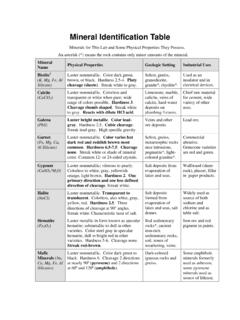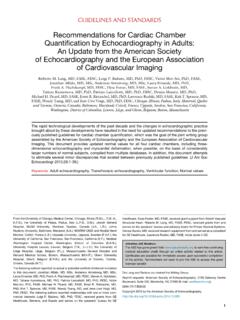Transcription of Examples of Groupings for Variations - GOV.UK
1 Page | 1 Examples of Groupings for Variations Version: 9 October 2014 General information on grouping of Variations can be found on the MHRA website or CMDh website. It should be kept in mind that, unless the grouping follows an example published by CMDh, MHRA or EMA or is listed in Annex III of Commission Regulation 1234/2008 (as amended) or is similar to a grouping request that was previously approved by the MHRA, acceptance of the proposed grouping requires prior approval via the Regulatory Information Service (RIS; Further information on how to submit this request can be found here. In the majority of cases, MAH are able to submit a grouped variation directly to the MHRA without the need for prior approval using the above published Examples as justification.)
2 However, prior grouping approval should always be sought for complex cases. The following Examples may help you further in identifying suitable scenarios in which changes to a Marketing Authorisation (MA) may be grouped. Unless indicated, prior approval from RIS is not required for the listed Examples of acceptable Groupings however the proposed grouping should be justified in the application by reference to the relevant example . Grouped Variations attract grouped variation fees; see here for current fee information. Note: The usual definitions of a MA and MAH as stated in Commission Regulation 1234/2008 (as amended) are applicable.
3 For products authorised as part of European procedures, a Marketing Authorisation is defined as all strengths and pharmaceutical forms of a certain product (Global MA) as defined in the numbering system (UK/H/1000/001) by the Medicinal Product Number part (1000) with, as appropriate, the strength and/or pharmaceutical form being defined by the speciality number (001). The global Marketing Authorisation can therefore include multiple Product Licences (PLs). As far as purely national products are concerned a Marketing Authorisation (MA) corresponds to a single Product Licence (PL). Table of Contents Examples of quality grouped Variations .
4 2 Examples of clinical grouped Variations ..6 Examples of grouping of Type IA changes only ..8 Examples of common non-approved Groupings and alternative submission strategies ..9 Bulking of Page | 2 1. Examples of quality grouped Variations grouping of similar (not identical) changes between different formulations/presentations/strengths, Variation to extend the shelf-life to 48 months for two products of a MA which contain the same active substance in different presentations and currently have different shelf-lives (24 and 36 months) provided there is some overlap in the supporting stability data. Variation to the active substance and finished product sections, Change of the manufacturing site of an active substance that is manufactured in-situ, as the finished product.
5 Does not require prior RIS approval if they are clearly consequential but is not allowable if they are totally unrelated. This is in line with CMDh guidance ( CMDh example of not acceptable grouping : The inclusion of changes to the active substance and finished product, unless they are totally related ). Changes to the Active Substance section ( ), The update of an Active Substance Master File (ASMF) and any consequential changes to the active substance and exceptionally, if relevant, finished product specifications may be grouped. The update including changes of the open as well as the restricted part - can be submitted as a grouped variation according to the highest type of the single changes.
6 This definition of grouping is in line with condition 5 of Annex III of the Variation Regulation; prior approval is therefore not required. In the example below the variation would be submitted as a Type IB. Note: In case of substantial changes in the updated version of the ASMF it is recommended to submit a single (rather than a grouped) variation of type II under category Page | 3 Submission of a new CEP that does not state a re-test period grouped with submission of additional stability data in support of the re-test period. This submission should be made as a Type IB. Changes to the Finished Product section ( ), Introduction of a new manufacturing site for the finished product grouped with other changes, in batch size, manufacturing process, including in-process controls, changes in site responsible for packaging (primary and secondary), batch release and quality control.
7 All these changes are regarded as belonging to the same project as described in Annex III of the Regulation All Variations in the group relate to a project intended to improve the manufacturing process and the quality of the medicinal product concerned or its active substance and therefore do not require prior approval. This submission should be made as a Type II. Note: If a site change results in a large number of changes to the dossier, prior dialogue with the MRHA regarding these submissions is recommended. Addition of more than one pack size, where at least one of the proposed pack sizes is outside the range of currently approved pack sizes.
8 This submission should be made as a Type IB. Page | 4 Replacement of the finished product manufacturing site and change of the active substance manufacturing site (supported by CEP and all data for the finished product is obtained using the new drug substance supplier). This submission should be made as a Type IB/II (as appropriate). Changes to excipient specifications, parameters, tests or acceptance limits. grouping of changes to more than one excipient is acceptable. This submission should be made as a Type II. Other quality changes ( or ), Changes to multiple analytical methods within one specification, the finished product specification in example A below, or if the same method is applied to the drug substance and finished product ( example B).
9 This submission should be made as a Type IB. Note: This should usually not be grouped with changes to manufacturing sites, see also comments above under , unless prior approval of the grouping has been agreed with the MHRA. example A example B Page | 5 Including of product information changes with quality Variations , Label and leaflet changes that fall under the self-certification scheme can be included with quality changes that affect the product information, change in storage condition. A separate self-certification submission is not necessary for the additional non-consequential changes which should be included in the variation form.
10 This submission should be made as a Type IB. Note: Self-certification notification changes may also be included with clinical Variations (see under ) but should not be included with quality/clinical changes that do not affect the label or leaflet. Product name changes, Invented product name change can be grouped with minor changes to the product literature typographical changes or wording in line with the QRD template or introduction of an own label supplier which should be included in the variation form. This submission should be made as a Type IB. A change in the product name in more than one MS of a MRP/DCP marketing authorisation can be submitted as a grouped application in case a different product name in each MS is proposed, since it falls under situation 4 listed in Annex III of the Variation Regulation (provided all Variations in the group relate solely to changes of administrative nature to the SmPC, labelling and package leaflet).
















